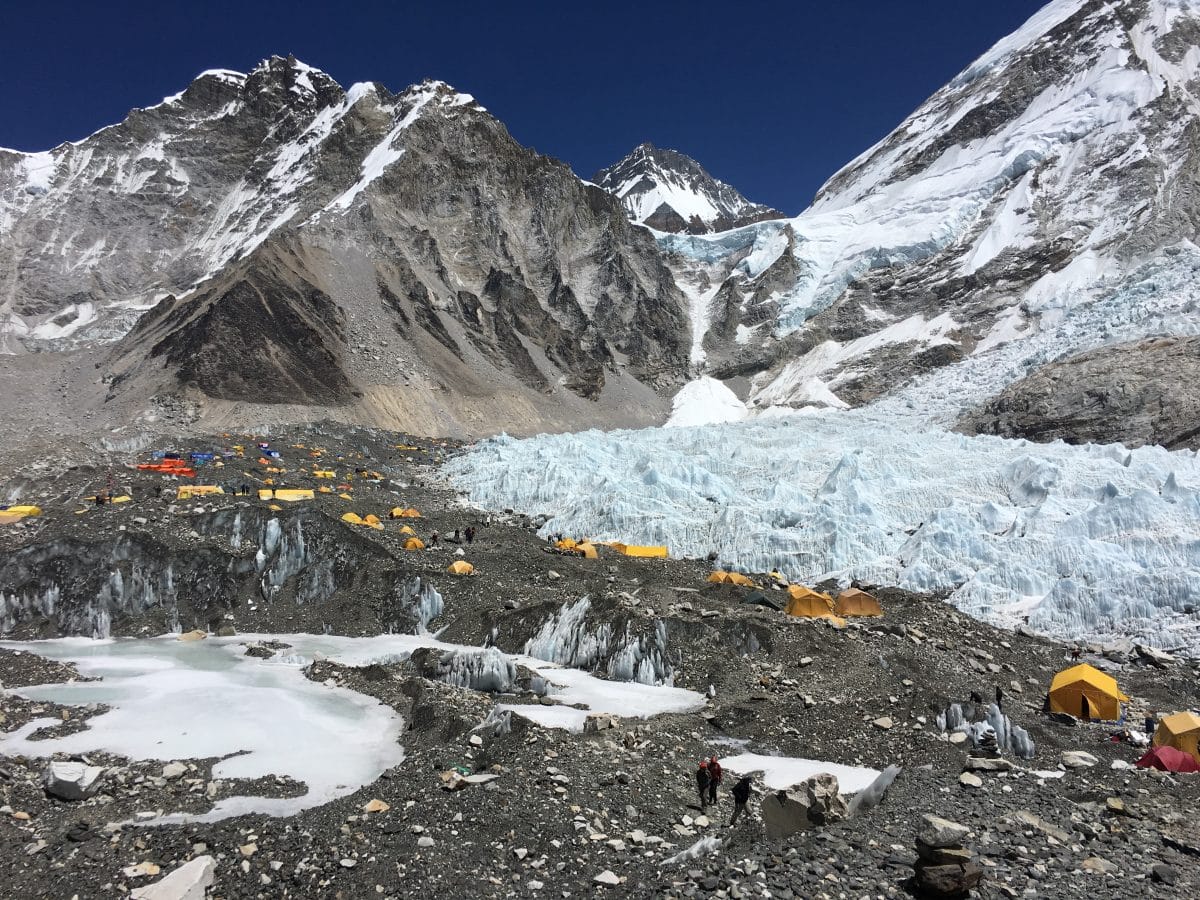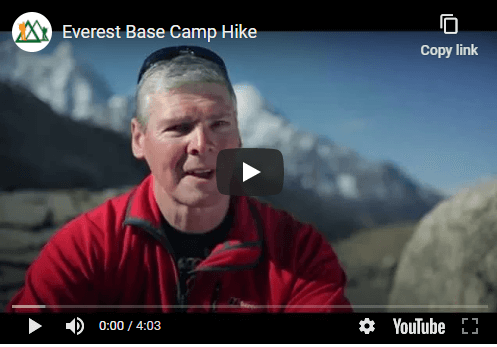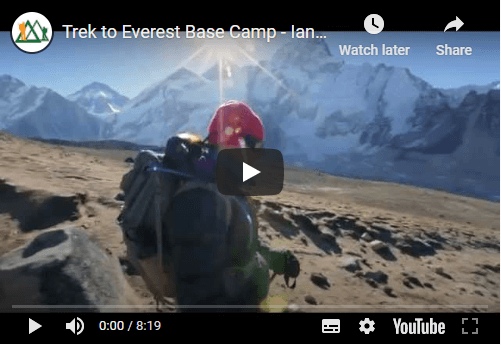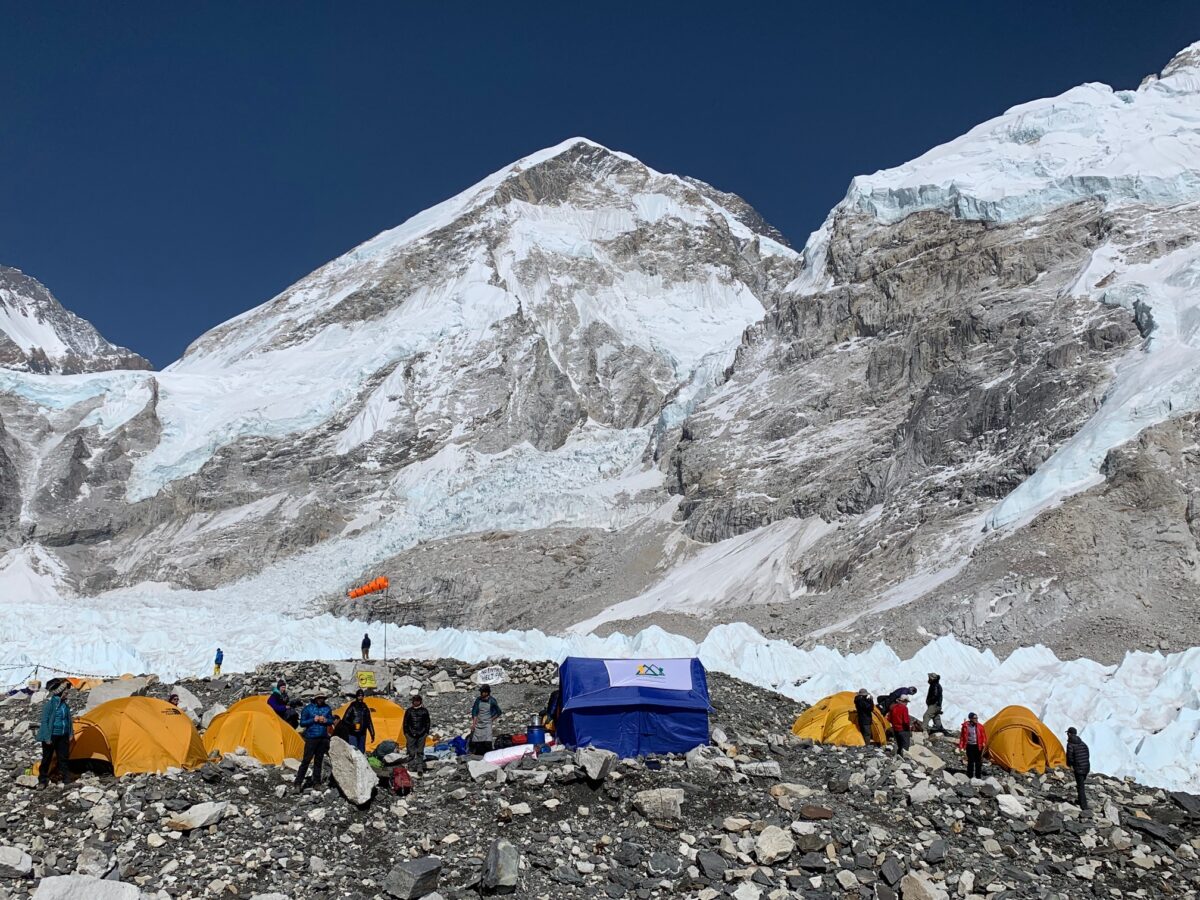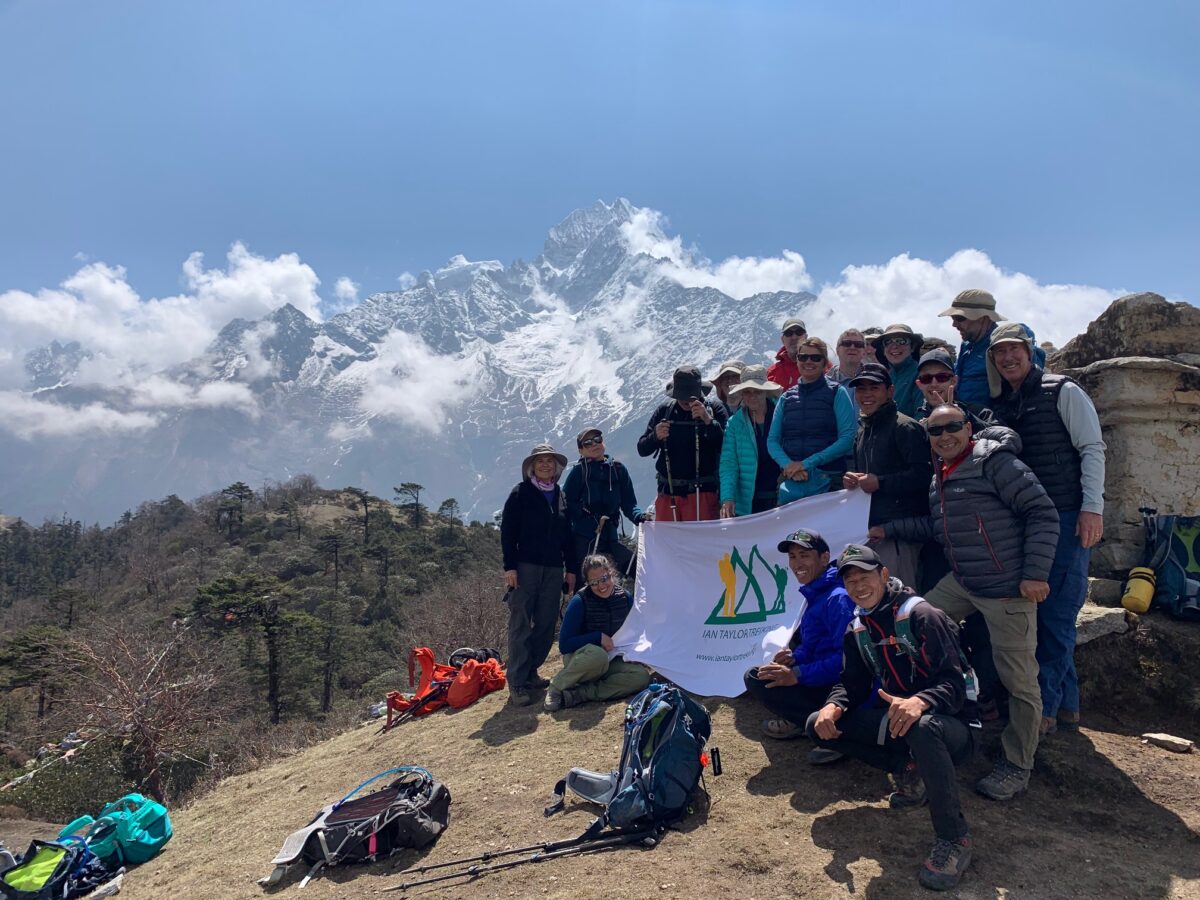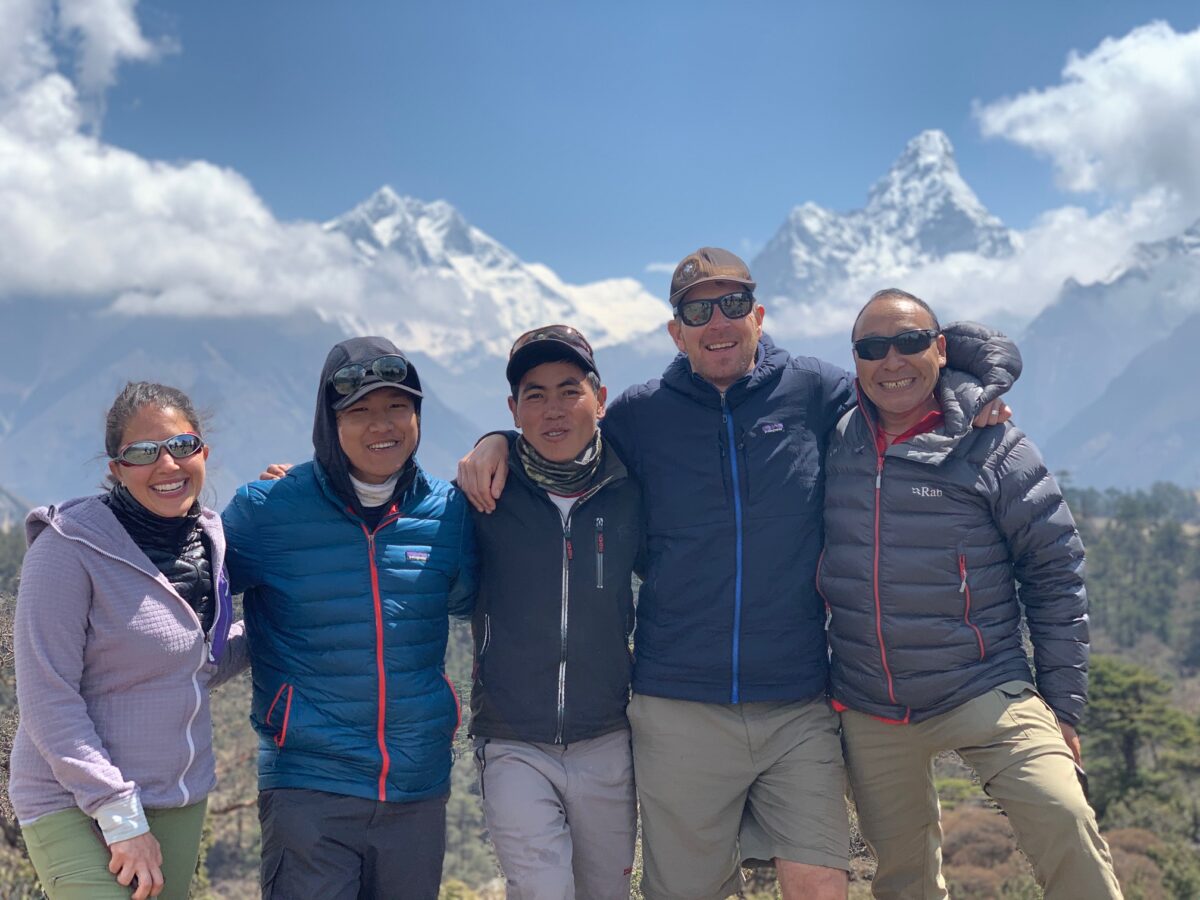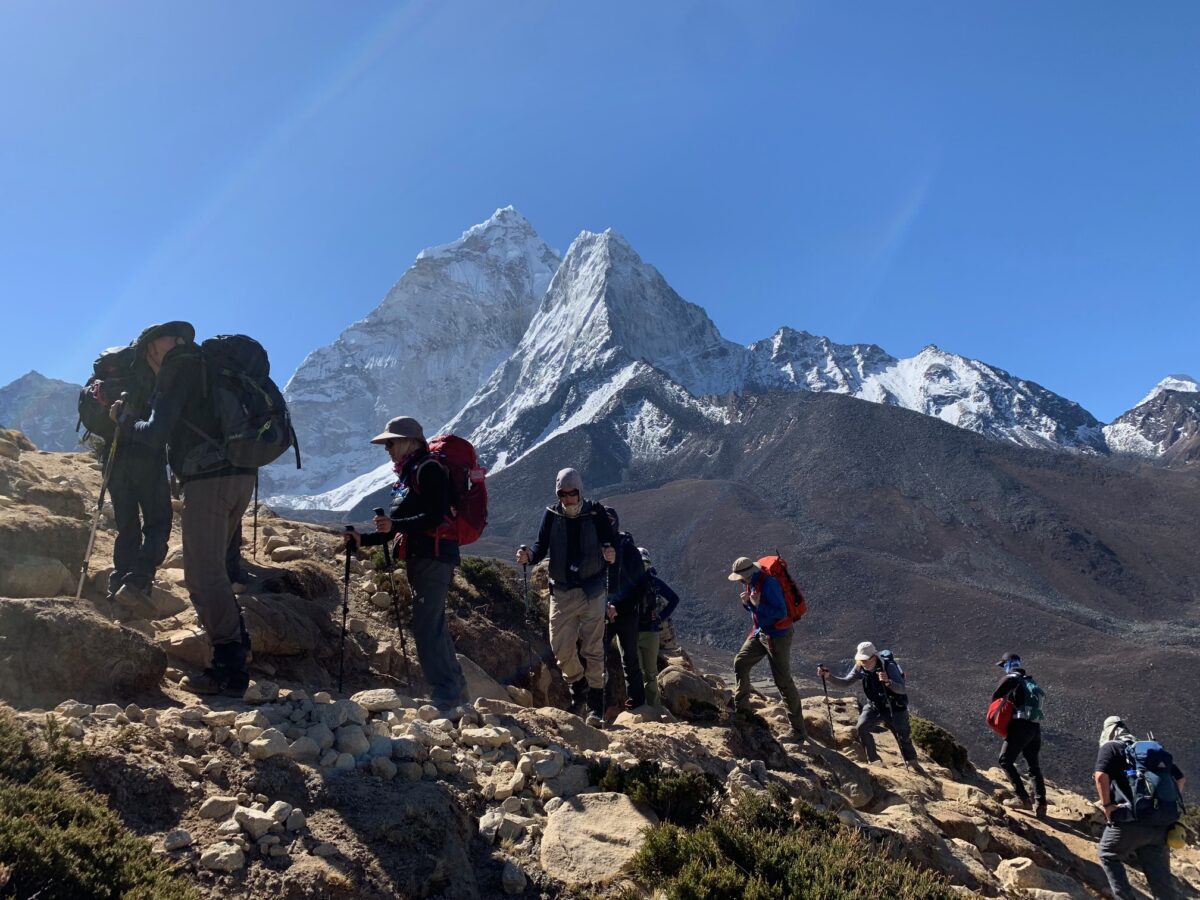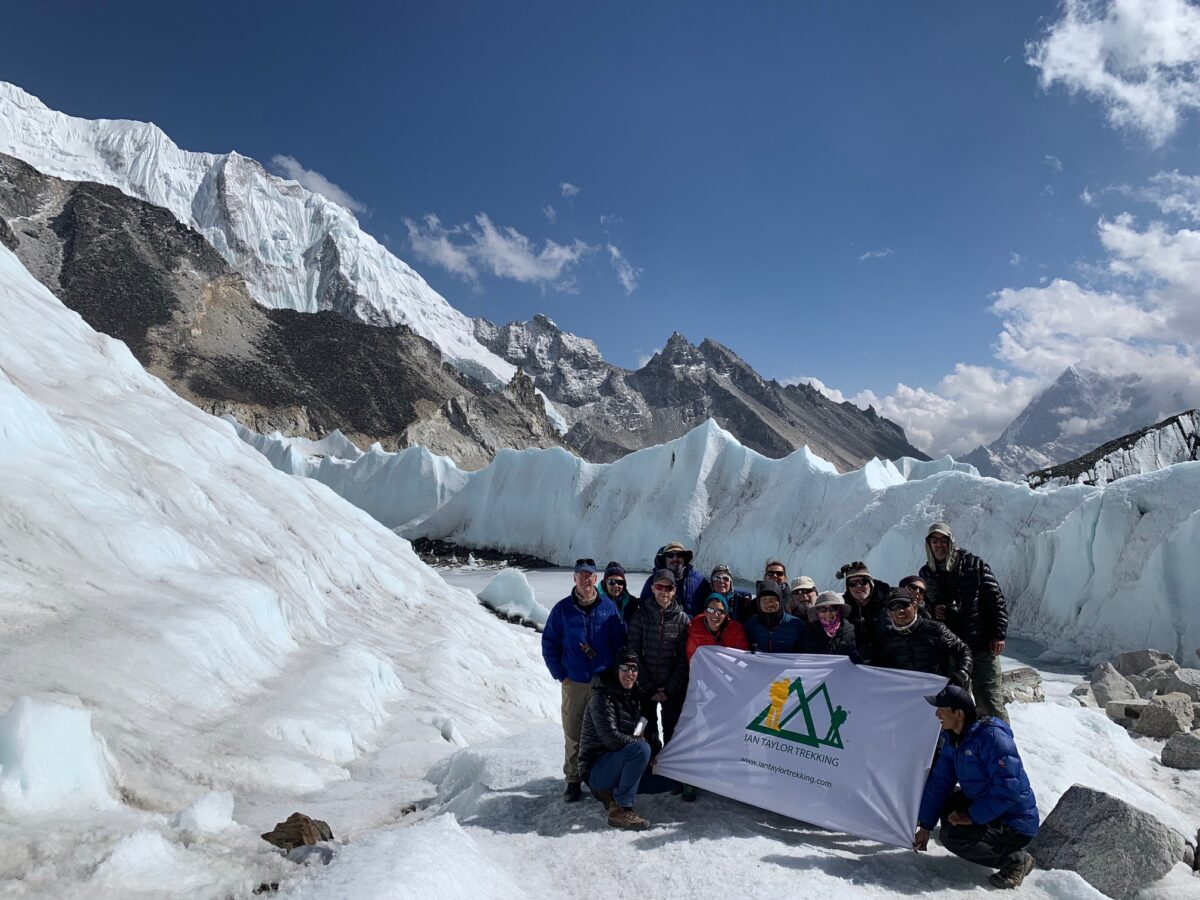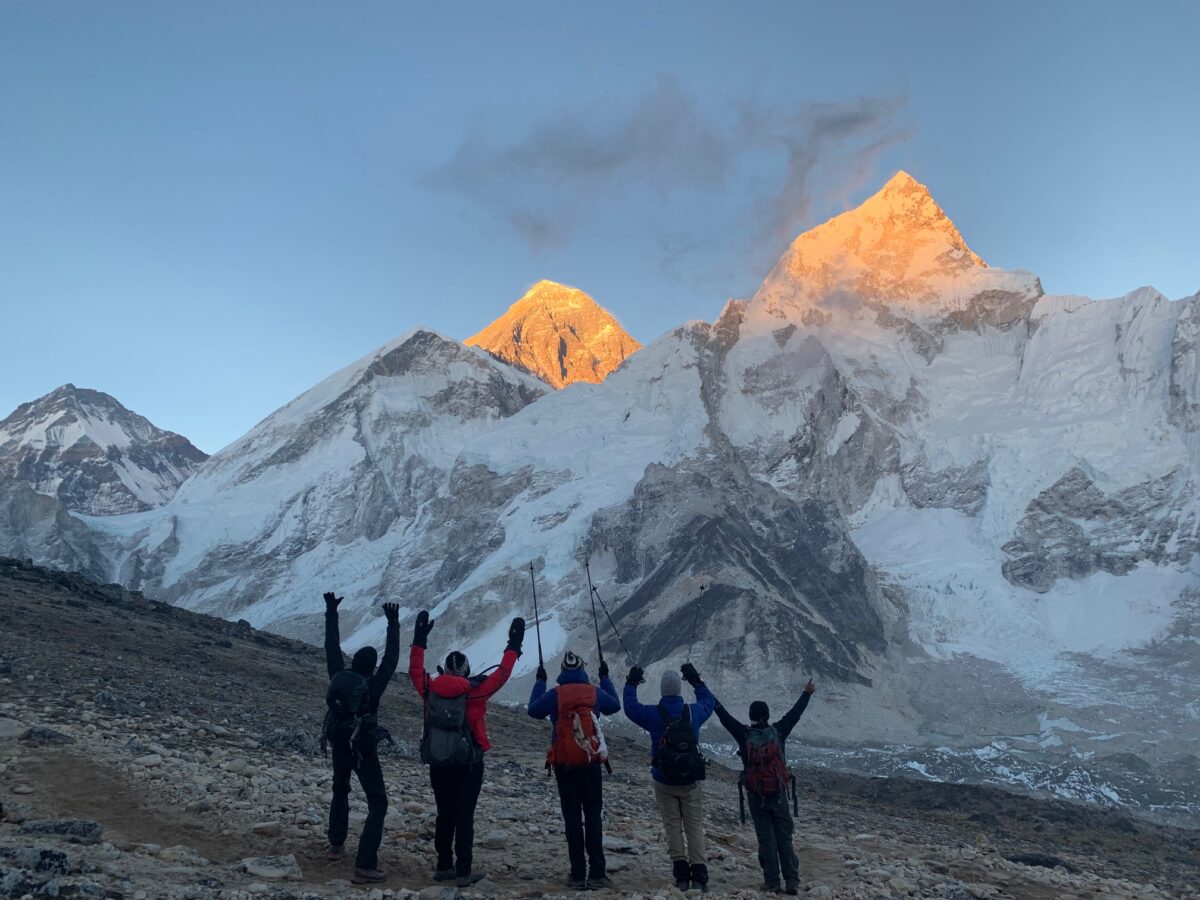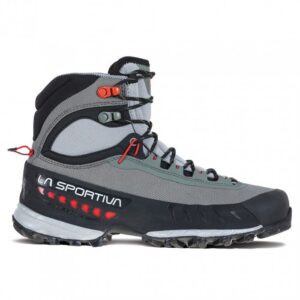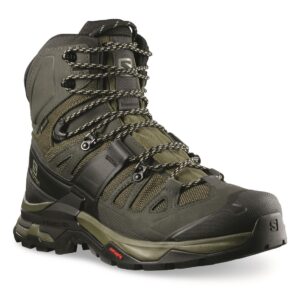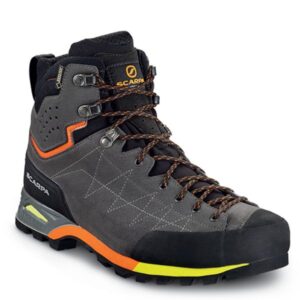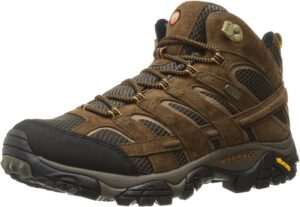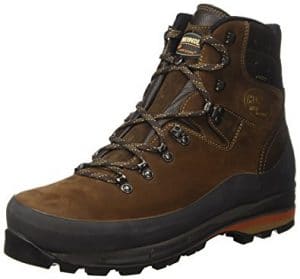Sleeping at Everest Base Camp
The Everest Region and Sagarmatha National Park hold some of the world's most scenic vista’s. You will experience magnificent views of Mount Everest, Lhotse, Ama Dablam, and Thamserku, to name a few. You will also venture through Sherpa villages like Namche Bazaar, Pangbouche, Dingbouche before sleeping at Everest Base Camp, sampling the wonderful hospitality these genuine people have to offer. The cost of our Sleeping at Everest Base Camp Trek start from $3,500.
Tips & Advice
1). Our Team
We have four guides for every group of ten trekkers on the trail! This is not the norm in the region and we do this because we want to make sure all of our teams have the best chance at safely reaching their goal. With more staff on the trail with your team, they will be able to more efficiently manage your safety on the trail and also give you a better experience along the way.
We do not outsource any of our treks and we have our own office in Kathmandu and our own staff who manage all of our trips. Therefore, this gives us far more consistency in our service on the ground. We have world class climbing Sherpa’s working with us and therefore, this helps us offer you quality treks, climbs and expeditions on every trip.
2). Supporting the Community
We continue to support the local community and have helped to establish the Goli Village Trust in Nepal. This was put into place after the earthquake in 2015, when the Village where many of our staff have come from was devastated. We have built two schools in the Goli region and we have placed stoves in over 60 homes. We do need donations and help, therefore if you would like to donate, set up a trek to the village, give funds, clothes or school items, then get in touch. Please let us know and we can help you figure out how you can best help!
3). Quality Trips
We run only run quality treks with more staff, better lodges and better food. Read some REVIEWS from our trips. You can also watch our Food and Accommodation video for further information. A lot of times people are only given the same food each day for every meal, and we don’t do this. You are allowed to pick what you eat for each meal to make sure that your dietary needs are met.
We pay our staff correctly and do not over load them with weight. Also, we use Yaks to carry all the loads where possible and we do not cut corners on any aspects of our treks or climbs. There will be a maximum of 10 people per group on our trips and we have 4 guides and support staff for 10 people.
4). Expert Training Advice
We offer personal service with training advice for our clients, 5 days a week. A lot of people underestimate the trek to Everest, and rely on helicopters to get them out of the region when they become too tired to continue. We do not want to see this happen with our clients. Therefore, we want to make sure that you have the best information on how to complete the trek safely and successfully.
There are some long 8+ hour days, covering over 20km with over 700m/ 2,296 feet of up and down hill on steps or stairs while on the trail. We have professional training advice available to you 5 days a week. All you have to do is e-mail us at info@iantaylortrekking.com, and we can schedule calls with you as often as needed once you sign up to our trips.
5). Sleeping in Everest Base Camp
We are the first trekking company to be able to offer an option for you to Sleep one night in Everest Base Camp! This is a very unique and special opportunity for trekkers as it has only been reserved for expedition team members in the past. However, we do want to limit our footprint in Base Camp, so we do only offer a limited number of these trips a year. Having the opportunity to wake up at the base of the worlds highest mountain is one not to be missed!
6). Trek with an Everest Summiteer
Why not sign up to one of the trips that Ian personally leads? You can walk through the region with someone who not only has gone to Base Camp over 35 times, but also has reached the top of Mount Everest! Ian usually leads two Everest Base Camp treks a year, combined with an Island Peak ascent which he has completed over 17+ climbs, and if you book far enough in advance, you could join him! Sign up and get access today. READ MORE.
7). 25 Years Experience
We have years of experience managing teams on the ground in Nepal. Our head guide has been at the forefront of tourism in Nepal for over 25 years. He is well connected on the ground with access to all the key organization and authorities. He is also passionate about the Sherpa culture, experience and preserving these traditions.
Anyone who has trekked with Dawa Chirri Sherpa will never forget it! Even if you just get to spend time in Kathmandu with him, you will love and cherish the experience. Dawa is married to Kay from Scotland, and they run our office together in Kathmandu. All of our clients joining trips to Everest Base Camp will experience the hospitality and quality service we have to offer.
8). Fully Trained Staff
All of our guides hold current Wilderness First Aid Certificates. They are able to get you the help you need in case of an emergency. Also, our guides will carry satellite and local phones with them. We bring oxygen on all our treks and climbs and the tea houses we use also house supplies of oxygen for emergencies. We lead climbs on Island peak, Mera Peak, Lobuche, Tent Peak, North Col, Cho Oyu and so many more. You need to have access to oxygen and team who have additional support staff members available to assist you while you are on the trek to Mount Everest. Read some REVIEWS from our treks to Everest.
9). Quality Gear
On our Sleeping in Base Camp trips, we use quality, North Face Tents on all our trekking and mountaineering itineraries in Nepal. We do have the option for a single tent for your night sleeping in Base Camp, however all accommodation are on a shared basis. Our Everest Treks are in the better lodges, however, if you are in a private group, you can chose to camp all the way if you prefer.
10). 4 Star Hotel in Kathmandu
We include two nights in a hotel in four star hotel in Kathmandu. One night before your trek and one night after. All of our trips are on a shared basis, but if you prefer a single room, this can be offered at an additional cost. We use the Yatri Suites and Spa in Thamel, which is the main tourist district of the city. You can also upgrade to 5 star hotel option if you like, just ask us for further information.
11). Better Lodges
There is a wide range of accommodations in the Everest Region. Some of these are of a very poor quality/standard and we stay away from those! We use the better accommodations when available. All of the tea houses we use come with a pillow and comforter on your bed. You still need to have your own sleeping bag with you, but these better tea houses will provide a cleaner and more comfortable option along the way. We use Hotel Namche for the four nights we spend in Namche Bazaar. Three nights on the way up and one night on the way down the trail. Sleeping is a very important part of the acclimatization process and therefore getting to bed early and getting as much rest as possible is very important.
12). We Run over 30 Treks to Everest Base Camp per Year
We have the experience and expertise to run over 30 treks a year to Base Camp. Ian Taylor Trekking are a well known and respected company in the region. Because of this, we get preferential treatment with everything from flights in/out of Kathmandu, to helicopters and room availability in the tea houses. Many companies without this experience bring you into the region and don’t even have tea houses booked beforehand. This could ultimately leave you stuck without a place to stay during busy times. We would never put our clients in this predicament… we are always booked beforehand to offer you a no-stress experience!
13). Three Meals a Day
Food in the Everest Region has become increasingly more and more expensive. All of our trips include three, two course meals each day on the trail. Therefore, you do not have to worry about bringing extra funds for your food. READ MORE information about our food service on the trek. We can guarantee quality food throughout the trek because we use the better lodges available and they provide a higher standard of meals. Making sure you get enough food on the trail is very important. Therefore, we provide all your meals as part of your trip.
14). More Acclimatization
We have learned after years of experience that people need more time to acclimatize to the lower levels of oxygen, in order to have a safe and successful trip. Therefore, we now include three nights in Namche Bazaar at 3,500m/ 11,500 feet. This will help to give your body the time it needs to acclimatize correctly. Most companies are not doing this and we have seen over the years that it is a main factor in why more people on our trips are making it to Base Camp! We also include two nights in Dingbouche at 4,350m/ 14,271 feet, giving you the best chance of success!
15). Animals not Porters
We use animals instead of people to carry your duffel bag on the way to and from Everest Base Camp. The Yaks will carry up to 15kg/33 pounds of your personal gear on the trail. We will send you our 45 page dossier covering all aspects of the trip. This will also include an itemized kit list for you to review. We are available to speak with you on the phone or Skype get the right gear for your trek. Watch our PACKING VIDEO and do let us know if you have any questions.
16). Celebration Meal
We like to treat all of our teams to a celebratory meal at the end of your trek in Kathmandu! Ian’s favorite restaurant to enjoy after he is in the mountains is Fire and Ice Pizza Restaurant. Most of our teams will have the meal there as you can enjoy some delicious pizza after the trek (maybe even have a delicious mojito). This meal is included in the trip. You will be presented with your Everest Base Camp certificate of achievement and we will enjoy a beautiful meal before heading back to the hotel or a night out on the town.
17). Different Itinerary Options
We have multiple options for itineraries to Everest Base Camp. You can join our regular trek itinerary, Sleeping in Base Camp itinerary, Gokyo Lakes Itinerary or the Three Passes Trek! We can also tailor your trip to suit your needs for a private group. Therefore, if you have 4 or more people joining a trip, we can cater your private itinerary at no extra cost!
18). The Best Sherpa Team
If you want learn about the Sherpa people, then you have to hang out with Sherpa people. Our team of Sherpa guides and assistant guides are happy and proud to talk to you about the Sherpa people, culture and way of life! We have been working with our teams in Nepal for over 10 years now. They are some of the most wonderful and knowledgeable people you will meet in the region. Most of our teams also take the time in Namche Bazaar to visit Kanchha Sherpa, the only remaining Sherpa from the first Everest expedition. Giving you a chance to hear from him and ask questions of what it was like then!
19). Small Group Sizes
We only work with small group sizes. The maximum number of people per team will be 10 people. Some of our groups are even less people with only 6 or 8 team members. This will therefore give you are more personalized experience on the trail to Everest Base Camp. You can move as a team and experience more of this world class trail.
20). Private Groups with Free Space
We have an amazing opportunity for private groups of 10 or more hikers to get one free space! Therefore, if you are a part of a hiking group, walking club, group of friends or family that all want to go to Base Camp, gather 10 other paying clients to go and we will give one space for free! You can read more about this offer HERE.
We only run quality treks to Everest with 4 guides for every group of 10 trekkers. Having more staff on our trips gives you a safer and more enjoyable experience. We lead around 50 trips per year into the Everest region of Nepal. Over the years, we have become a world leader in offering quality run treks to Everest Base Camp. We are happy to schedule a free personal assessment with you.
Read are TOP 50 TIPS
We Have our own Full Time Staff on the Ground
All our office staff in Colorado have trekked to Everest Base Camp over 8 times. Likewise, they have slept at Everest Base Camp and climbed local peaks in Everest region like Island peak, Mera Peak and Lobuche peak. Therefore, if you sign up with us, you are getting the best available information about how to train and fully prepare for your trek to Everest Base Camp.
Preparation & Training
Day 1). Fly Into Lukla
The Lukla airport sits at a height of 2,850m/ 9,350 feet. From there, you will walk through the town before going down hill for 315m/ 1,033 feet. After that, you will then head back up 315m/ 1,033 feet over uneven terrain. This hike today will take approximately 6 hours. We always aim to reach Monjo on the first day of our treks. However, if we arrive late into the mountains, we aim for Phakding, which take 3 hours. There are lots of steps up and down on this part of the trail. Distance: 13km/ 8.8 miles
Day 2). Namche Bazaar
If we have made it to Monjo the day prior, then you will start the day with a hike up 740m/ 2,427 feet up hill, over suspension bridges on uneven terrain to reach Namche Bazaar. There are some short down hill sections on steps and it will take approximately 4 hours to reach Namche. After crossing through Jorsalle and into the Sagarmatha National park, you drop down hill over another suspension bridge before hiking alongside the river and up steps to the high suspension bridge. From the high bridge you need to pace yourself as it will take two hours, uphill, to reach the village of Namche Bazaar. Distance: 8km/ 5 miles
Day 3). Acclimatization Day
We spend 3 nights in Namche Bazaar, which greatly aids in your acclimatization and therefore gives you a safer and more successful ascent to Everest Base Camp. You hike up 120m/ 400 feet to the Sherpa Museum to acclimatize. This is just a short 30 minute hike each way. The team will relax up at this elevation for a few hours, and learn more about the Sherpa culture, the national park and keep adapting to the lower levels of oxygen. Distance: 1km/ .6 miles
Day 4). Acclimatization Day
Today is our second day acclimatizing in Namche Bazaar. Having three nights in Namche gives our clients the best chance of a safe and successful trek to Base Camp. Today, the team will hike up 460m/ 1,500 feet up and 460m/ 1,500 feet downhill. Today will be approximately three to four hours of trekking. The trail will take the team up and down steep steps up out of Namche Bazaar to Shangbouche Hill. However, the views from Shangbouche Hill will be worth the effort! More acclimatization will help you as you move higher. Distance: 3km/ 1.8 miles
Day 5). Tengbouche
Today we will hike up out of Namche Bazaar and then traverse the side of the mountain gaining 260m/ 850 feet of elevation. Then, you will drop down 300m/ 984 feet to the lunch spot. After lunch, you will have the steep uphill Tengbouche Hill, which is 600m/ 1,968 feet. This hill alone takes 2 hours to get up to Tengbouche. The total time trekking today is about six hours. This is another challenging day for a lot of people. Pacing, hydration and lots of prior training is needed. Distance: 12km/ 7.5 miles
Day 6). Dingbouche
Today you will first hike down 110m/ 360 feet to the river side and then go back up 518m/ 1,673 feet passing through Pangbouche on route to Dingbouche. The hike today will take approximately six hours and you will reach a new height record. Distance: 12km/ 7.5 miles
Day 7). Acclimatization Day
Our trips all spend 2 nights in Dingbouche to further aid in the acclimatization process. Today, you hike up 490m/ 1,600 feet and back down 1,600 ft. The trek will take about four hours and this is an important acclimatization day. The mountains start to get very close and if the weather is clear this is one of the best mountain scenes you will ever see. Distance: 3km/ 1.86 miles
Day 8). Lobuche
Today you will move towards Lobuche. Firstly, you will move on gradual terrain, as you hike up 520m/ 1,700 feet. You will reach Thukla for your early lunch. After lunch, you will begin the uphill trek up the Thukla Pass. This will take approximately 45 min to one hour. At the top of the Thukla Pass you will have time to enjoy a break at the Everest Memorial. Then, from the Memorial, the incline is more gradual uphill to Lobuche. The total time hiking today will be approximately five hours. Distance: 12km/ 7.5 miles
Day 9). Gorak Shep
Today we make our way to Gorak Shep and then hike up Kala Patthar for the stunning sunset view over Mount Everest. You will hike up 725m/ 2,379 feet and down 600m/ 1,968 feet. Today should be approximately seven hours of trekking. You will leave at 8am and will arrive in Gorak Shep by 11am. You will rest, hydrate and have lunch. In the afternoon the team will start the steep hike up Kala Patthar for the amazing sunset view on Mount Everest. Today is a long and challenging day, but you will finally reach your goal of Everest Base Camp. Distance: 8km/ 4.9 miles.
Day 10). Sleep at Everest Base Camp
You can enjoy a relaxed morning. The team will have lunch and then hike into Everest Base Camp. It is a 2 hour hike into Everest Base Camp as you cross rocky glacial moraine up and down as you make your way into Everest Base Camp. The elevation gain is 300m/ 984 feet up and down. Once in Base Camp you can explore some of the famous Khumbu Glacier and then have a nice dinner prepared by our staff and experience sleeping on the Khumbu glacier for the night. Distance: 3.3km/ 2 miles
Day 11). Everest Base Camp – Pheriche
You will wake early and enjoy the views of Everest Base Camp before packing up and retracing your steps back to Gorak Shep for some Breakfast. After breakfast you will continue back through the glacial moraine to Lobuche, down the Thukla pass and drop into the lower valley towards Pheriche. The elevation uphill 365m/ 1,200 feet, and down 1,365m/ 4,478 feet. The total time hiking today will be around eight hours! This is another long day with a lot of distance to cover. Distance: 14.8km/ 9.2 miles
Day 12). Namche Bazaar
You will be up early today for the long road back to Namche Bazaar. Overall, today you will hike down 1,000m/ 3,280 feet and up 450m/ 1,476 feet on route to Namche Bazaar. Today is a long day, however reaching Namche and the showers in your room will be a treat! The total journey today will take about eight hours. Distance: 19.3km/ 12 miles
Day 13). Lukla
This will be your final day of trekking as you make your way back to Lukla. We will aim to get back to Lukla in the early evening after a long day of trekking. The return flight back to Kathmandu will be the following day. You will hike down 700m/ 2,296 feet, and up 365m/ 1,200 feet today. The total time of hiking is around eight hours, however, once you reach Lukla, you know that you have completed your goal! Distance: 21km/ 13 miles
Putting a Training Plan in Place
There are a few factors you want to consider when planning your training routine. Firstly, you want to look at the daily distances on the trek. This will show you how far you will have to walk each day, back to back. Then, start to look at the elevation gains you will have on each day of the trek. This is going to show you how much up-hill and down-hill you will have each day. Once you look at both of these factors, and consider the lack of oxygen at high altitude, and you can start to put a training plan in place. Contact us and let us help you figure out the right way to be training to build your strength and endurance.
What Does The Everest Trek Involve
1). 12+ days of continuous hiking
2). Carrying a backpack with 6+kg/ 12+lbs for hours up and down hills
3). Hiking for a minimum of 5+ hours each day
4). Covering over 6,000m/ 20,000 feet worth of ascent and descent during the journey to Everest base camp and back.
5). On the way back down you will be hiking 20+km/ 12.4 miles per day on uneven terrain up and down hills.
6). All of this will be done at high altitude (Between 2,500m/ 8,202 feet and 5,500m/ 18,000 feet). Extreme altitude is above 5,550m/ 18,000 feet. At extreme altitude, people can not live or survive, and will ultimately die if you stay there for an extended period of time. You will be trekking where there is 30% to 50% less oxygen getting to your muscles. Therefore, your muscles are missing valuable oxygen to help you move, recover and sleep.
Train with Weight on your Back
Essentially, you need to be able to walk 10 miles a day in your training on a multi day basis. Also, your training always needs to be done with a weighted backpack as you built up to the trek. On the trail you will need to have a proper backpack with a good waist strap, and you will carry 6kg+/ 12lbs+ in that pack. In your training, you will want to be comfortable with carrying double that amount of weight.
Strength and Endurance Training is the Most Important
When you arrive in Lukla Airport, you are already at 2,850m/ 9,383 feet. You are entering the realm of high altitude, with 20% less oxygen than you would have at sea level running through your blood stream and muscles. You have to walk for 9/10 days to reach Everest base camp at 5,364m/ 17,598 feet and climb Kala Patthar at 5,645m/ 18,520 feet. Once you are at Everest Base Camp, there is 50% less oxygen in the air than you are used to breathing.
Then, you have to return back to Lukla Airport over 3 days and that means you have to cover long distances each day. The entire trip, there and back, covers 75+ miles, all of which you are walking. If you want your muscles and body to cover this distance, at high altitude, then you need to train and condition your muscles prior to arriving in the Himalaya’s. You need to be getting this muscle conditioning, or muscle memory, by walking up and down hills, with a weighted pack, prior to your trek.
Not everyone will have access to hills, but this is the best way to train your body and legs for down hill hiking. Depending on your chosen adventure you do need to assess the level of downhill. We have elevation gains available for all of our key trips. I encourage you to review the daily elevation drops and what type of terrain you will be walking on.
For example, on our Inca trail treks you will be drop 700m/ 2,296 feet to 1,000m/ 3,280 feet on different days all on steep rocky stairs. On Kilimanjaro you will drop 2,800m/ 9,186 feet in one day on scree and rock and this is very challenging on your legs and joints.
You have just walked for days on end you have reached your goal but not you have to retrace your steps, often in a quicker time frame. Hiking downhill will take its toll on your joints. Fore sure, the downhill hike will take more wear and tear on your joints and muscles than the uphill.
You do need to use effective training techniques to minimize the impact on your body. Descending using good technique means that you move faster and feel lighter. Remember, 80% of accidents happen on the way down.
Keeping Knees Healthy
We live in Eagle-vail Colorado with amazing access to altitude and a wide range of mountain terrain to train on. In Colorado we can train all year round on hilly terrain preparing for Kilimanjaro, Himalayan trekking and mountaineering trips. I know most of you are joining our trips from sea level and with minimal access to hill training. I encourage you to get out to Colorado doing some multi-day hiking in preparation for your chosen adventure.
If you do not have access to hills and mountains, you must figure out other ways to prepare your knee joints to handle downhill stress. From a knee perspective, downhill hiking means eccentric loading and typically thousands of repetitions of it. Eccentric loading (the lengthening phase of a contraction) is especially challenging to what is called the patellofemoral joint of the knee. This is where the knee cap, meets the femur. Inadequate strength, poor mechanics and lack of exposure to this type of loading can turn downhill forces into injury producing stress. Prior to your trekking trip you need to start implementing sport specific training into our general preparedness programming.
Hiking Uphill and Downhill
Hiking uphill is all concentric muscle action (muscle active while shortening) at the knee joint without any eccentric loading (loading while muscle is lengthening). Concentric only exercises tend to cause less mechanical stress, load and pain to joints and tendons than do exercises that have eccentric phases. What goes up must come down.
You must prepare our body and specifically your knees to handle downhill hiking. Depending on the trip, you really need 6 months of some sport specific training into our general preparedness programming.
The strength movements below are similar but slightly different in specific ways. We purposely only hit each one once per week because too much volume of these exercises could quickly lead to an over training injury, so be careful. I would recommend adding in additional hip flexor and quadriceps mobility work at the end of your training sessions as well to maintain good length tension relationships and to protect your spine.
The Point of These Exercises
Increase vertical loading volume of the knees with a sight posterior to anterior (back to front) force vector. Get exposed and accustomed to decelerating the vertical and forward forces using primarily a knee strategy. Transition from doing most lunges and squats with a 3 points of contact foot position to a more heel elevated position where we contact and press through the forefoot.
The 3 points of contact foot position is the most stable position for the foot and encourages a balance of hip and thigh musculature – great for general preparedness training. Transitioning to a heels elevated position where the forces are applied through the forefoot places most of the stress on the quadriceps and knees – optimal for downhill hiking training.
Exercises for Downhill Hiking
You should consider adding these movements into your weekly training 2 times per week. Add 3-5 sets of 10-15 repetitions (per leg)
1). Heels Elevated Goblet Squat
2). Forward Alternating Lunge with Farmers Carry Loading
3). Forward Alternating Drop from Box Lunges
4). Banded Posterior to Anterior (PA) Forward Lunges
Carrying Weight
One of the best ways of mitigating the risk of musculoskeletal issues is by carrying a light pack. Then build up the weight you carry over time. An overly heavy backpack is not recommended in the early stages of your training.
Extract its biggest toll on your body during steep and/or long downhill sections, so a hiker should always aim to travel as lightly as the dictates of their skillset and the environment into which they are venturing allow.
If you are carrying weight on longer hike you should slowly build up the weight you carry. You should also consider carry water uphill and dump as much water/ weight as possible for your downhill. Always assess the weight you are carrying for each hike and always build up slowly over time. You do not want to get injured.
Our Unique Itinerary
Day 1 - Arrive in Kathmandu – 1,400m/ 4,500 feet
Arrive in Kathmandu International Airport as early as possible on this day. We will provide your airport transfer to the hotel we include for the night. All accommodations on the trek are on a shared basis. If you want to arrive in early, that is not a problem, we are happy to book additional nights in the hotel for you. We will have a group briefing this evening to go over the schedule for the coming days and answer any additional questions you may have.
Day 2 - Fly to Lukla – Trek to Monjo – 2,850m/ 9,350 feet
Fly from Kathmandu to Lukla. We will make an early morning start for the Twin Otter flight to Lukla (2,840m/9,317ft), the gateway to the Khumbu Region. This is an exciting flight, which should give a glimpse of Everest in the distance. In Lukla, we will meet the rest of our trek staff and set off straight away for our first night in the mountain village of Monjo. Depending on what time the flight arrives in Lukla, we may have to stop in the town of Phakding (2,600m/ 8,530 feet) for the night. Hopefully, the team will make it all the way to Monjo. Both villages are situated on the banks of the Dudh Kosi, which drains the whole of the Khumbu Region, and is the main trade route for the entire region. This can be the busiest part of the trail. Today we will walk for 3 hours to Phakding and a total of 5 hours to Monjo. The total distance is 8.8 miles/ 13 km to Monjo from Lukla.
Day 3 - Namche Bazaar – 3,440m/ 11,286 feet
Today we will continue up the banks of the Dudh Kosi River, towards Namche Bazaar. Just past Monjo, we will officially enter the Sagarmatha National Park before following the trail through small villages. We will take a tea break along the way. After tea, the trail then crosses the confluence of the Dudh Kosi and the Bhote Kosi, on a high suspension bridge. The trail then climbs steeply uphill for about two hours to reach Namche Bazaar (3,440m/11,286 feet). This is a prosperous trading town and the capital of the Khumbu Region. Just across the valley to the east stand the peaks of Thamserku and Kangtega, both very impressive mountains. From Monjo, the trek today is approximately 4 hours and the total distance is 5 miles/ 8 km.
Day 4 - Namche Bazaar (Acclimatization Day) – 3,600m/ 11,800 feet reached
Today is an acclimatization day where we will walk to the Sherpa Museum at 3,600m/ 11,811. From here you will have stunning views of Mount Everest and the surrounding mountains. The key is to rest, relax and acclimatize at this height and will make all the difference as we go to high and extreme altitude. The afternoon will be at leisure in Namche Bazaar, resting, eating, and enjoying the sites! Remember that it is still important to continue to drink 4-5 liters of water every day on the trail. Today, the walk up to the Sherpa Museum is only approximately 30 minutes.
Day 5 - Namche Bazaar (Acclimatization Day) – 3,900m/ 12,800 feet reached
This is where our itinerary is different. Instead of heading up to 3,900m/ 12,800 feet and sleeping in Tengboche, we will stay in Namche another night giving you the best possible acclimatization program. During this critical acclimatization phase, we will spend time resting and trekking to higher altitudes to aid in the process. We will wake early for our acclimatization hike today, up to Shangbouche Hill at 3,900m/ 12,800 feet, for beautiful vistas of the whole Everest Region. The goal is to spend some time acclimatizing at this elevation before returning to Namche for lunch. The afternoon can be spent sampling the delights of the Namche Bakeries and local stores! The hike to Shangbouche Hill will take approximately four hours round trip.
Day 6 - Tengbouche – 3,900m/ 12,800 feet
Today we will leave Namche and trek to Tengbouche at 3,900m/ 12,800 feet. From Namche, the well-worn Everest trail contours around the side of the valley high above the Dudh Kosi. As we follow the path, we will get excellent views of the great peaks of the Khumbu; Everest, Lhotse, Nuptse and Ama Dablam. Passing by several villages, we will descend approximately 300m/ 984 feet down to the Dudh Kosi River, where we stop for lunch. After lunch, we will make the steep 700m/ 2,296 feet uphill climb to Tengbouche. This is the home of the impressive and famous Tengbouche Monastery. You can visit the Monastery or the local bakery this afternoon. The hike will be approximately 5 to 6 hours today and covers 7.5 miles/ 12 km.
Day 7 - Dingbouche – 4,350m/ 14,271 feet
We will continue up the trail to Dingbouche today. Shaded by Rhododendron trees, the trail crosses an airy suspension bridge just beyond Debouche. From here, the trail continues approximately an hour before reaching the village of Pangbouche. From here, there are excellent views of Ama Dablam ('Mother's Charm Box') and where we stop for tea. If there is time, we may be able to visit the local Monastery, which was the first in the Everest Region. Contouring up the valley, we will re-cross the river and turn up the Imja Valley to reach the picturesque farming village of Dingbouche at 4,350m/ 14,271 feet above sea level. The hike will take approximately 5 – 6 hours today and cover 7.5 miles/ 12 km.
Day 8 - Dingbouche (Acclimatization Day) - 4,900m/ 16,000 feet reached
Today is spent as another acclimatization day at this critical elevation. Just above the town, while on our acclimatization hike, we will have stunning views of three 8,000/ 26,200 feet peaks; Makalu, Cho Oyu and Lhotse. Our goal today is to ascend to 4,900m/ 16,000 feet for some of the most beautiful views on the trip. This is one of Ian’s favorite days of the trip! After enjoying the views and spending some time at this new elevation, we will descend back to Dingbouche for lunch. The afternoon will be free to enjoy the village of Dingbouche and relax before some more challenging days ahead. The trek today will be approximately 4 hours round trip and you will gain 550m/ 1,804 feet of elevation.
Day 9 - Lobuche – 4,940m/ 16,207 feet
Today we will trek to Lobuche, continuing along the upper trail towards Thukla at 4,620m/ 15,157 feet. Ahead of us is the Lobuje East Peak at 6,119m/ 20,075 feet, and to our left is the formidable north face of Taweche. After approximately three hours walking slowly, we reach the small collection of lodges at Thukla where we will stop for an early lunch. After lunch, we continue the walk up for approximately one hour uphill to the Everest Memorial. From the Memorial, there are outstanding views of Ama Dablam, Cholatse and Taweche. After leaving the Memorial, the trail continues gradually parallel to the famous Khumbu Glacier, that runs off Mount Everest. After approximately another hour, the trail will eventually lead to a small cluster of tea houses pleasantly situated at Lobuche at 4,940m/ 16,207 feet. The total trekking time will be approximately 5 – 6 hours today and you will cover 7.5 miles/ 12 km in distance.
Day 10 - Gorak Shep (5,180m/ 17,126 feet) to Kala Patthar (5,645m/ 18,520 feet)
Today will be a long and very rewarding day! We will be up early to start our trek to Gorak Shep, which takes approximately 3 hours to reach 5,180m/ 17,126 feet. Today is a very challenging day on the trail, as we cross glacial moraine on mixed rocky terrain with a lot of up and down hill to cover. Gorak Shep was the site of the 1953 Everest Expedition's Base Camp and where we will stop for lunch. After lunch, you will check in to your room and relax before heading up Kala Patthar in the afternoon to see the sun set over Mount Everest. The trail from Gorak Shep leads steeply uphill all the way to the top of Kala Patthar at 5,645m/ 18,520 feet. This takes approximately 2 hours to reach the top and the views off Kala Patthar are spectacular and you will be rewarded with the famous view of Mount Everest! After enjoying the mountain views at the top, we will return to Gorak Shep, which takes about one hour for the evening. Today we will hike for approximately 6 hours.
Day 11 - Everest Base Camp (5,364m/ 17,600 feet)
Today is another big day, but one to remember forever! Today is the day you have been waiting for, where you will reach the base of Mount Everest and spend the night under the stars! We will take our time this morning, have a nice relaxing breakfast and rest before lunch. After lunch, we will begin the approximately two-hour trek into Base Camp. From Gorak Shep, we will traverse more glacial moraine, with landslide potential, before reaching Everest Base Camp! Everest Base Camp sits on the Khumbu Glacier and when you arrive, you will see the Ian Taylor Trekking campsite ready for your arrival! You will enjoy the splendor of Base Camp and enjoy a traditional Dhal Bhat meal prepared for you by one of our cooks. The evening is spent exploring and marveling at the beauty of this unique place! You will sleep in a shared tent with your roommate. Total trekking time today is approximately 2 hours.
Day 12 - Pheriche – 4,200m/ 13,780 feet
After spending the night in this unique location, you will be waken with hot tea/coffee/chocolate and snack before packing up your duffel bag and making the return journey to Gorak Shep. Here, we will have breakfast and warm up, before we head back down the trail. We will then retrace our steps through the Lobuche, the Everest Memorial and usually stop in Thukla for lunch. From here, we will take the lower trail to the village of Pheriche at 4,200m/ 13,780 feet, for the night. The total distance today is approximately 11.7 miles/ 19 km and will take about 7 – 8 hours.
Day 13 - Namche – 3,440m/ 11,286 feet
The trek today will be another long and challenging day. From Pheriche we head back through Pangbouche, then uphill into Tengbouche where we stop for tea. From Tengbouche, the trail continues downhill for one hour to our lunch spot, beside the river. After lunch, there is a one hour and thirty minute ascent, back up to the Ama Dablam View Guesthouse, where we will have a final short break. There is another approximately hour and thirty minutes before we reach Namche Bazaar. This is a long day as we will only arrive in Namche in the late afternoon. It is now time to take a shower, relax and get some rest! The hike today is approximately 8 hours and will cover 13.7 miles/ 22 km.
Day 14 - Lukla – 2,850m/ 9,350 feet
Today is the final day of trekking!! It will be another long day as we must get all the way back to Lukla for the night. The day starts with a one hour descent from Namche, back to the high suspension bridge. Following the river from here, you will have to trek up and down stairs and trails, retracing our steps back to Phakding, where we will stop for lunch. After lunch, it will be a gradual two-and-a-half-hour ascent back into Lukla at 2,850m/ 9,350 feet. The hike today will take approximately 8 hours and we will not reach Lukla until late afternoon. The distance covered today is 13 miles/ 21 km and you will enjoy your final night spent in the Everest Region tonight.
Day 15 - Fly to Kathmandu – 1,400m/ 4,500 feet
We will wake early today and have breakfast before returning to the Lukla Airport for the flight back to Kathmandu. If the weather is cooperating, then you would be back in the hotel in Kathmandu by early morning! You can spend the day at Leisure in Kathmandu, enjoying the sites, including Pashupatinath, Swayambhunath and the districts of Bhaktapur and Patan. Durbar Square is also on the essential list, as is the shopping area of Thamel or get a treatment at one of the many spas in Kathmandu. We include a celebration team dinner in a nearby restaurant and the night in the hotel is also included on a shared basis.
Day 16 - Kathmandu
Today is the final day of our itinerary. We recommend that you do not book your return flight until no earlier than the evening on this day. That will be critical if there are any delays getting out of the mountains on the day before. We include your return transfer back to the international airport for your onward journey. If you want to spend any extra time in Kathmandu, we are happy to book additional nights for you in the hotel.
Packing for Everest Base Camp
Remember that the gear you bring will also depend on what time of year you are doing the trek. You will need warmer layers if you are trekking in February, March, November and December.
Watch What Ian will Pack
This video is designed to show what Ian would bring on his trek to Everest Base Camp. Ian has made the journey to Everest Base Camp 40+ times, stood on the top of Everest and led treks in different conditions. This is the gear and clothing Ian has used on his numerous treks and expeditions into the Everest region. From recent treks, Ian recommends adding a down vest as an additional layer on the trek to Everest.
No One Size Fits All
Learn from Experts
1). La Sportiva TXS GTX
This is a new boot from La Sportiva, that has replaced our beloved Trango Trek GTX. We prefer a more rigid sole under foot and these boots do a great job. They are warm, lightweight and waterproof. Some of our Sherpa and Kilimanjaro guides wear these boots as well. Ian used these boots on four Kilimanjaro climbs this year along with three Everest Base Camp trips, and they are still in great condition for the same again next year. We would also use them training and on other treks in Nepal and South America.
2). Salomon Quest 4 GTX
Another great option is the Salomon Quest 4 GTX Trekking boots. More and more people are using these trekking boots on a wide range of our trekking adventures in Nepal and around the world. They are comfortable, sturdy, waterproof and a very resilient trekking boot. We would recommend these boots for Everest Base Camp, Kilimanjaro, Mount Elbrus, and a range of other treks.
3). Scarpa Zodiac Plus GTX
Scarpa has come out with a new light weight option in the Zodiac. These boots are Gore-Tex, so a waterproof boot to keep you dry if you experience moisture on the trail. They also have good ankle support and lacing system. These boots, similar to the La Sportiva TXS, have a more rigid sole, which is ideal for the terrain on the trail to Everest Base Camp. Scarpa are always re-inventing trekking boots and if they fit your foot correctly, then they may be the right boot for you. They work great and last a long time. We would also recommend these boots for a Kilimanjaro climb, Elbrus or the Inca Trail.
4). Merrell Moab Mid 2 Waterproof
The Merrell Moab Mid 2 Waterproof Trekking Boot has been around for years and there is a good reason for that, they are a great boot! These boots boast a waterproof membrane, good ankle support, comfortable and sturdy fit. The Merrell boot may be the option for you if you have a slightly wider foot or need more room in your toe box. This boot is a reliable and durable option that will be ideal for your Everest Base Camp Trek! We would also recommend this boot for Kilimanjaro, Annapurna Base Camp or the Inca Trail.
5). Meindl Vakuum
You could also consider using the Meindl Vakuum trekking boots. These are a good option for Everest Base Camp treks and a wide range of trekking peaks and multi-day trekking adventures. These are a very popular boot and we see a lot of clients arriving to Nepal in this option. They are an excellent choice for mixed rocky terrain and long distance hiking. These boots will be with you for many miles as they are an extremely durable boot. Also, this could be a good option for you if you feel the cold in your feet as they will be a warmer option.
FAQ
Q). How much does a visa cost to enter Nepal?
A). Visa entry for Nepal costs USD $50 for a 30 day visa and USD $100 for 90- day visa.
Q). How much is a meal in Kathmandu?
A). An average meal in Kathmandu is approximately USD $10 – $15 per meal.
Q). How much should you tip your guides after a trek to Everest?
A). The tip given at the end of a trek back in Lukla should be roughly USD $200.
Q). Can I leave spare luggage in the Kathmandu hotel while I am on the trek?
A). Yes, the hotel we use in Kathmandu has a luggage storage room for any travel clothes or spare items you want to bring with you to Nepal, but not on trek.
Q). Where do I get water from on a trek to Everest?
A). You should use water purification tablets in the 4/5 liters of water you will be drinking each day. Avoiding water borne illness on the trek is imperative! You can buy these in Kathmandu or on the trail to Mount Everest. Bottled water (plastic) was meant to outlawed in the Everest region as of 2019, as of now you can still purchase bottled water. You will want to make sure that you have adequate amounts of water purification tablets with you for the entire trek. 30 minute treatment is ideal. Check when you purchase. You can also use a steripen.
Q). Is the Everest Region expensive?
A). The higher up the trail you go in the Everest Region, the higher the price tags are for items! Anything you want to purchase in the region has to be carried in on the back of a porter or animal, which is why things are more expensive the further they have to travel. Boiled water in Nalgene, for example, is between USD $2 – $4 and this will vary the higher up you go. Coffee can be $3 – $5.
Q). When is the best time to trek to Mount Everest Base Camp?
A). What time of year you should go to Everest Base Camp will depend on the experience you are looking for. Some of our favorite times to be in the region are late October into November and December, where the crowds start to dissipate and the temperatures are a bit colder, bringing the crisper and clearer views. Another popular time to visit is March and April. April is one of the busier months to be in the region – but there is a reason for that! Generally, the weather is stable and the views are clear, with less heat haze that can impede the views.
Q). When is trekking season in the Himalayas?
There are two distinct trekking seasons in the Himalayas; pre-monsoon (February, March, April and May) and post monsoon (late September, October, November and December). It is also possible to make the journey in January and early September. Our personal favorites are March, April, late October and November.
Q). When is the Everest Base Camp quiet?
A). The quietest time to visit the Mount Everest Base Camp are January, February March, September, November and December.
Q). When is the warmest time to visit Everest Base Camp?
A). May and September are usually the warmest time to visit Everest Base Camp. However, while we normally see warmer temperatures in May, we have also seen years where it has snowed on the trail and been quite cold along the way! You never know what the weather will be like in the region, but generally May is a warm time to be there.
Q). When is the main climbing season in Mount Everest?
A). The main climbing season on Mount Everest is April and May each year. This means that if you want to see Everest Base Camp with all the tents and action, then one of the trips during the months of March, April or May would be best for you.
Q). What vaccines do I need to get to visit Mount Everest Base Camp?
A). The recommended vaccines to receive before trekking to Mount Everest Base Camp include tetanus, Hepatitus A, Hepatitus B, Typhoid, Poliomyelitis, Rabies, Meningoccal Meningitis, Japanese Encephalitis, and the Covid-19 Vaccine.
Q). Which vaccines are required to visit Nepal?
Unless you are entering Kathmandu from tropical Africa, then there are no legally required vaccinations to enter or exit from Nepal. Even though there are no required vaccines, there are, however, some that are recommended. We suggest that you keep up to date with the current vaccine list through the CDC or your local Travel Medical Center. The recommended vaccines will also depend on when or where else you will be traveling when you visit Nepal as there are different recommendations for different regions. The general recommended vaccines to receive, however, include tetanus, Hepatitis A, Hepatitis B, Typhoid, Poliomyelitis, Rabies, Meningococcal Meningitis, Japanese Encephalitis, COVID-19, and Yellow Fever (only if traveling from a country with Yellow Fever).
Q). How do I choose the right lodges for a trek to Everest?
A). Ian Taylor Trekking offer some of the best accommodation on offer for every trek. Our service is second to none and we use the same lodges on every trek. The lodge owners know us and we know them. This helps us offer you consistency for your trek. We have been building relationships in the region for years to make sure you have the most comfortable experience on your journey to Everest Base Camp.
Q). Is it difficult to trek to Everest Base Camp?
A).One of the most common questions we get is people asking if it is difficult to trek to Everest Base Camp? This is a relative question. For people who are used to hiking long distances, with a weighted back pack over years, they might find the trek relatively easy. However, for people who have no access to hills, or that are not used to hiking or training on a regular basis, they will need to train hard for this trip and will likely find it very difficult. Likewise, the older you are, the more training is needed. Learn More.
Ian has journeyed to Everest Base Camp and Kala Patthar over 40+ times to date and climbed to the top of Mount Everest. Ian and other of our team members have made the journey many times, however, each time is different! Doing the correct training and putting in the right preparations for the trek will be essential to your enjoyment, safety and success.
Why Trek to Mount Everest with Ian Taylor Trekking
We only run quality treks to Mount Everest Base Camp, with the best staff, service, acclimatization, and itineraries. All of our teams have 4 guides for every group of 10 trekkers, which is not the norm in the region. We have developed a wonderful team of full time staff on the ground in Nepal, who work directly with us year round. We never outsource our trips. Ian Taylor has climbed Everest to the top and led over 40+ Everest Base Camp treks. Our team has the experience and knowledge on the journey and are here to help make sure you have the right advice and information for your trek to Everest. Pick up the phone or email us today to discuss your adventure to Sleep in Everest Base Camp in Nepal!
Ready to Book Your Sleeping in Everest Base Camp Trek?
If you need any further information, please feel free to get in touch with us directly! You can email us at info@iantaylortrekking.com and we will send through all the relevant information for your Sleeping in Everest Base Camp Trek! Once you sign up to one of our trips, we will send out a complete Dossier on your trip. This will help answer questions on preparation, gear, vaccinations and all the important information on your journey.
We are a world leader in running Everest Base Camp treks and would love to be a part of your adventure. Get in touch today and make the dream of standing at the base of the worlds tallest mountain a reality!


